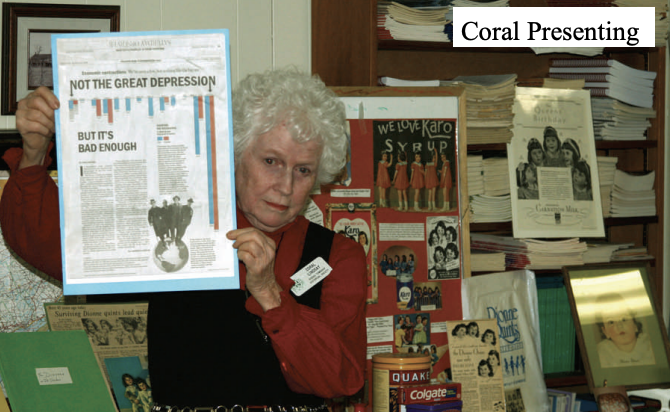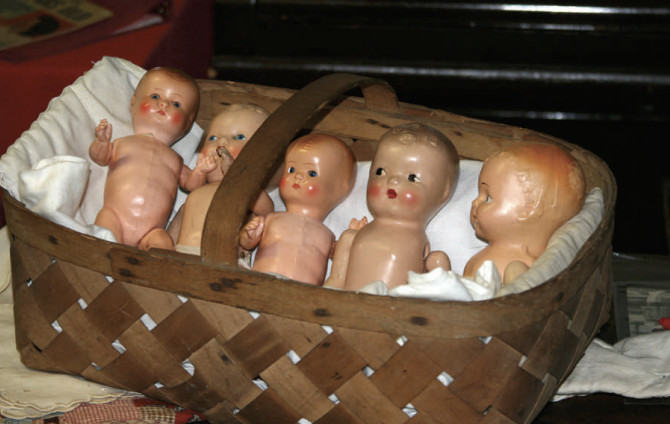9 Famous Children of the Great Depression
Presentation by Coral Lindsay to the RTHS membership, April 15, 2009. Presentation report by Ellen Adamsons
Coral Lindsay, our local historian, presented RTHS an entertaining, well researched and abundantly illustrated lecture about nine world famous children of the 1930’s Great Depression. Although the talk centered on the Dionne Quintuplet’s early years, the other four children Princess Elizabeth of York, Princess Margaret, Shirley Temple and comic strip character Little Orphan Annie were well represented on six display tables covered with charts, pamphlets, books and toys.

Coral explained that Canada was hit hard by the depression and men “rode the rails” seeking employment. There was no social safety net. Accepting relief implied the recipient was of bad moral character. At the height of the unstable economy, the Dionne Quintuplets were born into a French Canadian farm family near North Bay who already had five children.
News of the multiple natural birth of five babies hit the headlines around the world.
It was a miracle! Yvonne, Annette, Cecile, Emily, Marie and their mother survived rural home delivery.
The Chicago World Exposition promoters immediately contacted the father, Oliva Dionne, issued a cheque and sent electric incubators. Then the problems began. Once Canada Customs caught up with the news, they released the incubators they had originally seized. It was discovered that the farm had no electricity and no running water. A kerosene incubator was found to help four of the nine inch long babies breathe. The strongest child was kept in the farm kitchen warming oven. When the children started to turn blue Dr. Defoe diluted rum with water and gave each infant a few drops. It worked.

Credited with great medical skill, Dr. Defoe became a member of the Board of Guardians, when the Ontario government passed legislation to gain custody of the quintuplets, making them wards of the department of Health. The parents were deemed unable to look after the children. Coral presented contrary evidence. The Dionnes were capable, industrious, hard working and prosperous farmers even during the depression. However the family did win the battle of maintaining French as the girl’s first language.
Quintland, the hospital, where the healthy quintuplets lived for nine years became a tourist industry for the North Bay area. In 1935 over a half million visitors paraded through the one way glass viewing stations to see the quints, at play in the morning and afternoon; by 1936 there were one million visitors. Local roads were paved. Forty companies, such as Carnation Milk, Life Savers and Quaker Oats featured the children in advertisements. Coral explained that historians now question whether there was exploitation of the quints as well as improper accounting and distribution of their assets.
Once the girls got over the cute stage, tourism fell off and the economy also began to improve. Unfortunately the girls were not happy when they moved back home because they had not been taught how to milk cows or to do farm chores. They did not fit into rural life. Also there was resentment towards them among the older siblings. At eighteen the girls left home and moved to Montreal to live their lives privately.
Like many Canadians, Coral’s mother cut out every news item about the world’s five most famous children. Thus a life-long interest began for Coral who was three years old when the Quintuplets were born. Coral expressed thanks to Shirley Adams for the use of her Dionne scrapbook. If you want to know history, get to know Coral!
